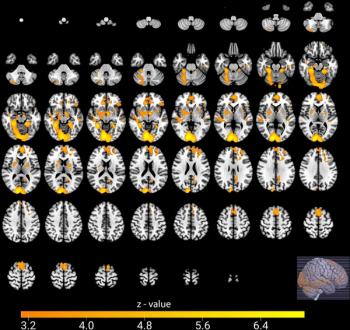
MRI Shows Brain Abnormalities in Some COVID-19 Patients
Multiple brain regions and cerebral spinal fluid can be affected.
Evidence continues to increase on the neurological impacts of COVID-19 infection. Research released Friday showed nearly half of all patients positive for COVID-19 who were admitted to the intensive care unit (ICU) showed brain abnormalities on MRI scans.
Published in
These findings underscore the clinical symptoms already identified in these patients. Current evidence has revealed that 6 percent of patients experience acute stroke and 15 percent develop an altered mental status. Cytokine storm syndrome can also be involved.
Related Content:
“Recent evidence highlights a relatively high percentage (36 percent) of central nervous system symptoms, including headache, altered mental status, acute cerebrovascular disease, and epilepsy in patients with COVID-19,” the team wrote. “The rate of neurological symptoms is higher in patients with more severe respiratory diseases status.”
To determine the neurological impacts, the team conducted brain MRI exams on COVID-19-positive ICU patients who were hospitalized in eight institutions – two academic and six academic-affiliated. Overall, 235 individuals were receiving care in the ICU. Fifty (21 percent) developed neurological symptoms, and brain MRI was performed in 27 patients (54 percent).
Of those patients imaged, 12 (44 percent) had acute findings on MRI. Ten patients had COVID-19-related neuroimaging findings – cortical FLAIR signal abnormalities, including increased cortical diffusion weighted signal with corresponding low ADC values (seven cases), subtle leptomeningeal enhancement (five cases), and punctate cortical blooming artifact (three cases). These abnormalities were involved in various areas: frontal lobe (4), parietal lobe (3), occipital lobe (4), temporal lobe (1), insular cortex (3), and cingulate gyrus (3).
According to the researchers, the main differential diagnosis for this group of findings is infectious or autoimmune encephalitis, seizure, hypoglycemia, and hypoxia. Cortical microhemorrhages and the breakdown of the blood-brain barrier can accompany hypoxia.
“COVID-19 with its neurotropic potential may result in infectious or autoimmune encephalitis,” the team wrote. “Certain viral and autoimmune encephalitis can have specific pattern of involvement that is helpful to establish a differential list, however non-specific imaging pattern in our series hinders achieving a specific diagnosis based on MRI.”
In addition, cerebrospinal fluid samples (CSF) were gathered in half of the 10 patients with cortical signal abnormalities. While four revealed elevated protein levels, cell counts, glucal levels, IgG index, and albumin were normal, and RT-PCR for both herpes simplex virus and SARS-CoV-2 – the virus that causes COVID-19 – were negative.
In 15 additional cases (55.6 percent), MRI images did not show any COVID-19-related or acute intracranial findings. Two CSF samples collected from this group showed elevated protein levels despite negative MRI images. In this group, chronic parenchymal changes or non-COVID-19 findings included chronic small vessel ischemic changes in four cases, infarct sequel in four, parenchymal atrophic changes in three, cavernoma in one case, and intracranial metastatic lesion in three cases.
It’s important to note, the researchers said, that the complex clinical course, including co-morbid conditions, such as diabetes mellitus, long ICU stays, respiratory distress with hypoxia episodes, can be confounding factors. Additionally, without more specific CSF findings, it can be difficult to establish a clear cause-and-effect relationship between COVID-19 infection and the MRI findings. Additional research is required, they said, to more fully understand which imaging findings are associated with neurotropism of COVID-19 and which are related to other etiologies.
“This report may help increase awareness for possible neurological involvement of SARS-Cov-2 for patients in the ICU and especially for patients who do not tolerate extubation despite improvement of respiratory findings,” the team wrote.
Newsletter
Stay at the forefront of radiology with the Diagnostic Imaging newsletter, delivering the latest news, clinical insights, and imaging advancements for today’s radiologists.


























